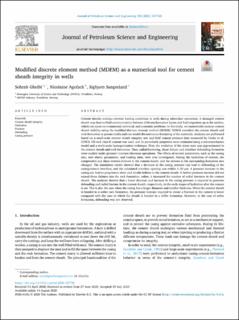| dc.description.abstract | Cement sheaths undergo extreme loading conditions in wells during subsurface operations. A damaged cement sheath may lead to fluid communication between different formation layers and fluid migration up to the surface, which can cause environmental, technical, and economic problems. In this study, we numerically analyze cement sheath stability using the modified discrete element method (MDEM). MDEM considers the cement sheath and rock formation as porous media and can model discontinuous fracturing of the materials. Analyses are performed based on a small-scale cement sheath integrity test and field cement pressure data measured by Cooke et al. (1983). Oil well class H cement was used, and its poroelastic properties were estimated using a micromechanics model and a multi-scale homogenization technique. First, the evolution of the stress state was approximated in the cement sheath and rock formation. Then, radial fracturing, shear failure, and interface debonding formation were studied under pressure increase/decrease operations. The effects of several parameters, such as the casing size, rock elastic parameters, and loading time, were also investigated. During the hydration of cement, the compressive and shear stresses evolved in the cement sheath, and the stresses in the surrounding formation also changed. The simulation results showed that a decrease in the casing pressure can lead to debonding of the casing-cement interface, and the calculated interface opening was within 1–50 μm. A pressure increase in the casing can lead to progressive shear and tensile failures in the cement sheath. A further pressure increase did not extend those failures into the rock formation; rather, it increased the number of radial fractures in the cement sheath. The analyses showed that a lower decrease and increase in the casing pressure is required to generate debonding and radial fracture in the cement sheath, respectively, in the early stages of hydration after the cement is set. This is also the case when the casing has a larger diameter and smaller thickness. When the cement sheath is bonded to a softer rock formation, the pressure increase required to create a fracture in the cement is lower compared with the case in which the sheath is bonded to a stiffer formation. However, in the case of softer formation, debonding was not observed. | en_US |

